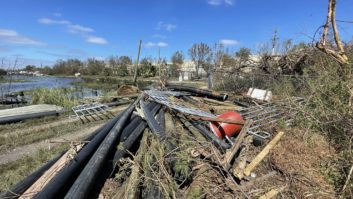
The access road, and vegetation, were washed away. It looks like a moonscape.
On the morning of Sept. 8, an unprecedented storm ravaged much of the Palm Springs, Calif., area, and in particular the top of a small desert spot near Palm Springs known as Edom Hill. At that location is a five-tower diplex array that transmits CRC Media West’s KXPS(AM) and KPSF(AM).
Intense amounts of rain in a short period of time created a cascade of mud and debris travelling down the desert mountains that accumulated and met up at what is known as Tower #2 at that site and proceeded to wreak havoc throughout the antenna field. By the time it washed past the inside of the guy wires west of Tower 3, the widest stream was 14 feet across.
Though the site is generator-powered, not surprisingly, both stations were knocked off the air by the deluge.
The access road to the site was wiped out with 4–6 feet of mud/sand/silt covering parts of the main road, Varner Road, for two miles. Most of the vegetation along with 12-inches of ground cover was washed away.
CRC Media’s local engineer Bill Watson was first on the scene and made initial damage assessments. I joined him and then Mark Mueller from Mueller Broadcast Design came along a couple of weeks later for further assessments. Mark had designed the KPSF directional array.
We observed the damage. Ground radials and large pieces of copper strap were exposed everywhere. The flood waters had caused mini “ravines,” for lack of a better word, that pulled and stressed all of KXPS’ recently buried lines that went from the transmitter to four of the five towers. Conduit used to create a basic cover for transmission and sample lines was pulled out of the ground and whipped around as if it were nothing.

Once buried radials were completely exposed.
All had to be relaid and reburied.
All of the flood waters that collected coming down just west of Tower 3 created a path that cut straight through to the deeply buried coax that ran to Tower 4.
Upon closer inspection things were stunning. We could tell by the sand on top of Tower 2’s antenna tuning units that they had been completely submerged underwater. The interiors were filled with a very fine silt-type sand, as was the filter box mounted to the side of KXPS’s ATU. The internal damage to the components inside was massive in all of our “boxes” at the Tower 2 compound
The KXPS ATUs were mounted on a concrete base with two pieces of thick angle iron. Those were bent backward and the box pressed all the way up to about 6 inches from the actual tower. Much of the ground beneath the concrete base had been washed away.
Fortunately, the towers, guy wire bases and the transmitter building were unharmed. One interesting note, the force of the water pulling on the transmission lines to Tower 2 were so strong that it pulled the coax right off of the connecting point inside the building and out into the conduit by about 15 feet.
Luckily, Tower 5, on “high” ground was unharmed and we were able to temporarily broadcast from it at reduced power within 24 hours of the initial failure.

An ATU almost pushed up against Tower 2 but by a
small miracle, an abandoned air conditioner somehow
wedged itself between the box and the tower creating a
buffer. The AC is the mangled debris beneath the box.
Remember, this box was originally mounted on a
concrete slab. Note the sand on everything.
Before we could start the cleanup we had to cut a new access road. It went around the facility and came in from the opposite side. It took several days before we could get a fuel truck up to the facility.
We eventually required backhoes, and many men with shovels for the work a backhoe could not do. All fence lines had sand blocking the gates, so those were dug out.
I dug out by hand the components in the sediment-filled ATUs. Not being able to see through the caked mud, it was an intentionally slow and deliberate cleanout that took several days. The back of the cabinet showed mud had reached 17 inches from the base.
We had to replace a contactor in KPSF’s Tower 2 ATU, and a damaged Jennings UCSXHF-450-35S vacuum capacitor that failed after the first test in the Tower 2 filter box.
All of the new lines that went to Towers 1, 2, 3, and 4 showed stress at the junction points. A team of four guys with shovels managed to get those lines set properly. After repairing and/or replacing tower lines to Towers 2 and 4, we reburied all of the line runs, repaired the fence at Tower 2, repaired many copper radials, and moved hundreds of tons of earth back over exposed copper. We tested all lines and with few exceptions, they tested very well.
This resuscitation all took place over a five-month period. The first work was performed early Sept. We pulled up all the lines and did the retrenching in the last week of September.

What we found inside the boxes.
The ATU had two key areas that needed repair (besides cleaning/replacing the components inside). The water bent the ATU backwards on its metal angle iron braces that were bolted to the back corners of the box and bolted at the base. We attempted to upright the box using a skiploader and a chain around the back, and slowly put pressure to bend the metal upright. It worked for the first few inches, but the metal snapped, and the box (very front heavy) slowly leaned forward until it touched the ground. The metal didn’t completely fall apart; it just couldn’t hold the weight of the box up moving forward. We initially supported the front of the box with cinder blocks, and later reinforced it with wooden posts bolted to the front frame.
As far as the ATU box and the filter box that were pulled apart during the storm, we used C-clamps to slowly bend the frame back to the housing, then used galvanized sheet metal screws to reattach the two boxes together.
During the rebuild process we secured the broken fence, and had it repaired by a local fence company after we returned to normal operations.
Mark Mueller showed up for his initial site assessment on Sept. 27. Mark got us partially back to normal, and we expected to have him back out in October. Delays in scheduling pushed the final repairs to January of 2015. In between (around December) we had the aforementioned capacitor failure. But during the five months we did have long periods of inactivity.
Amazingly, once everything was dug out, salvaged, cleaned, reinstalled or reburied, with only a few minor things needing replacement, we got back to full strength broadcasting.












